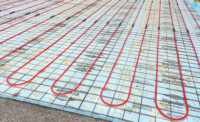How the digitization of contractors’ businesses will affect you
New experiences, new expectations

Image source: NicoElNino / iStock / Getty Images Plus via Getty Images
The COVID-19 pandemic drove many changes in the way businesses operate. In addition to government lockdowns and restrictions on physical interaction, these changes were also driven by consumer expectations. When lockdowns forced everyone home, many businesses digitized their processes, making five years’ worth of changes in merely six months.
Although physical distancing is no longer necessary, consumers have gotten a taste of what a well-executed digital experience feels like, and they are not going to relinquish those benefits. In order to address these newly solidified needs, contractors began adopting digital tools to provide the functionality end consumers demanded — and found advantages for themselves as well.
One tool that saw increasing use during the pandemic was a class of software called Field Service Management (FSM) software, which allowed contractors to extensively digitize many business functions. FSM software began as administrative software, to give managers one platform through which they can schedule appointments, track jobs, and monitor ongoing maintenance.
In order to facilitate this, tools were created to allow contractors to access information resources, create digital estimates, and document jobs. With the contractors’ business functions being digitized, when the pandemic hit, the creation of a digital experience for the end consumer was significantly eased. FSM software unified customer business interactions, allowing scheduling, documentation, invoices, billing, and payment to be centralized on one platform.
So, we understand what the software does; now, what experience does it create? For the end consumer, it is frictionless, where every interaction with the contracting company is conducted through one digital platform. The software centralizes information, minimizes delays, and provides a clear picture of the current state of their projects. For contracting company owners and managers, they can complete their day-to-day work quickly and efficiently, allowing them to focus more time on higher-value interactions. For service technicians, every aspect of their job feels streamlined and unified. From the assignment of a task all the way through its resolution, there is one portal through which everything is done. Much like the experience provided to end consumers, friction points have been minimized and the process smoothed.
Contractors and owners are aware of the possibilities presented by this class of software, and the kinds of services it can provide. This degree of unification has gone from being a fantasy to a luxury — something which not everyone has, but something everyone wants. Regardless of distributors’ actions, this kind of digital experience will inevitably become a necessity.
In many B2B fields, this has already happened. According to a recent study conducted by McKinsey & Co, 80% of B2B buyers will begin actively looking for new suppliers if their current partners are unable to provide real-time inventory, transparent online pricing and a consistent experience between all channels of communication.
Now, we should be clear that this does not mean that 80% of PHCP contractors are actively looking for new suppliers — yet. This is partially because the PHCP industry has historically been slow to adopt technology (on both sides of the counter), and partially because they don’t have to look far before finding big-box stores.
Contractors aren't actively looking for new suppliers — they’ve already found them. In light of these findings, how will you fulfill the growing contractor need for a digital, integrated, frictionless experience? Your ability to provide functional and practical digitized interactions will act as a key differentiator, both from your local competition, and from the behemoths that threaten all private distributors.
Have you considered what functionality contractors need, or how you will build the capabilities they want? Have you thought about how you will start the digitization and integration of your business functions? Are you thinking about the experience you want to craft for your contractors, and what obstacles are preventing its creation? Will you be prepared to fulfill these expectations when they go from being a luxury to a necessity?
Looking for a reprint of this article?
From high-res PDFs to custom plaques, order your copy today!






